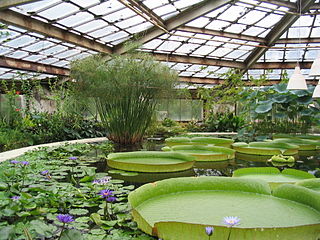
A greenhouse is a structure that allows people to regulate climatic conditions, such as temperature and humidity. There are many different designs of greenhouses; however, in general these buildings include large areas of transparent material to capture the light and heat of the sun. The three most common transparent materials used in the roof and walls of modern greenhouses are rigid plastics made of polycarbonate, plastic films made of polyethylene or glass panes. When the interior of a greenhouse is exposed to sunlight, the internal temperature rises and shelters the plants from cold weather.

A conservatory is a building or room having glass or other transparent roofing and walls, used as a greenhouse or a sunroom. Usually it refers to a space attached to a conventional building such as a house, especially in the United Kingdom. Elsewhere, especially in America, it can often refer to a large freestanding glass-walled building in a botanic garden or park, sometimes also called a palm house if tall enough for trees. Municipal conservatories became popular in the early 19th century.
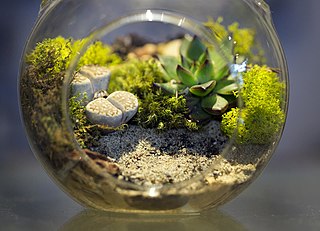
A vivarium is an area, usually enclosed, for keeping and raising animals or plants for observation or research. Water-based vivaria may have open tops providing they are not connected to other water bodies. An animal enclosure is considered a vivarium only if it provides quality of life through naturalistic components such as ample living space and natural decor that allow and encourage natural behaviours. Often, a portion of the ecosystem for a particular species is simulated on a smaller scale, with controls for environmental conditions such as temperature, humidity and light.
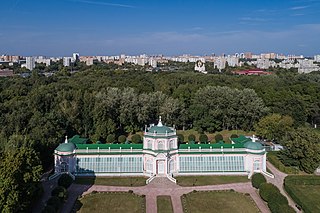
An orangery or orangerie was a room or a dedicated building on the grounds of fashionable residences of Northern Europe from the 17th to the 19th centuries where orange and other fruit trees were protected during the winter, as a very large form of greenhouse or conservatory.

The Darwin D. Martin House Complex is a historic house museum in Buffalo, New York. The property's buildings were designed by renowned architect Frank Lloyd Wright and built between 1903 and 1905. The house is considered to be one of the most important projects from Wright's Prairie School era.

The Conservatory of Flowers is a greenhouse and botanical garden that houses a collection of rare and exotic plants in Golden Gate Park, San Francisco, California. With construction having been completed in 1879, it is the oldest building in the park. It was one of the first municipal conservatories constructed in the United States and is the oldest remaining municipal wooden conservatory in the country. For these distinctions and for its associated historical, architectural, and engineering merits, the Conservatory of Flowers is listed on the National Register of Historic Places and the California Register of Historical Places. It is a California Historical Landmark and a San Francisco Designated Landmark.
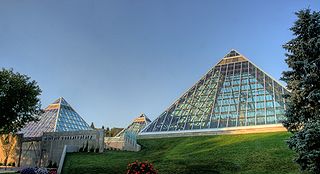
The Muttart Conservatory is a botanical garden in the North Saskatchewan river valley, across from the downtown core in Edmonton, Alberta, Canada. One of the best-known landmarks of Edmonton, the conservatory consists of three city-operated greenhouses, public gardens, as well as four feature pyramids for display of plant species found across three biomes, with the fourth pyramid hosting a seasonal display. A fifth minor skylight pyramid lights up the central foyer.
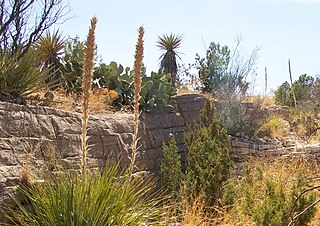
The Living Desert Zoo and Gardens State Park, formerly the Living Desert Zoological and Botanical State Park, is a zoo and botanical garden displaying plants and animals of the Chihuahuan Desert in their native habitats. It is located off U.S. Route 285 at the north edge of Carlsbad, New Mexico, at an elevation of 3,200 feet (980 m) atop the Ocotillo Hills overlooking the city and the Pecos River. It is open every day except Christmas.
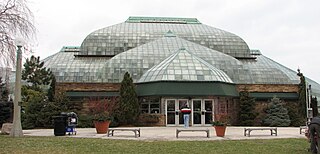
The Lincoln Park Conservatory is a conservatory and botanical garden in Lincoln Park in Chicago, Illinois. The conservatory is located at 2391 North Stockton Drive just south of Fullerton Avenue, west of Lake Shore Drive, and part of the Lincoln Park, Chicago community area. The Alfred Caldwell Lily Pool and the North Pond Nature Sanctuary are further to the north along Stockton Drive. Along with the Garfield Park Conservatory on Chicago's west side, the Lincoln Park Conservatory provides significant horticultural collections, educational programs and community outreach efforts.

Franklin Park Conservatory and Botanical Gardens is a botanical garden and conservatory located in Columbus, Ohio. It is open daily and an admission fee is charged. Today, it is a horticultural and educational institution showcasing exotic plant collections, special exhibitions, and Dale Chihuly artworks.

The San Antonio Botanical Garden is a 38-acre (150,000 m2), non-profit botanical garden in San Antonio, Texas, United States, and the city's official botanical garden.

The Conservatory Garden is a formal garden near the northeastern corner of Central Park in Upper Manhattan, New York City. Comprising 6 acres (24,000 m2), it is the only formal garden in Central Park. Conservatory Garden takes its name from a conservatory that stood on the site from 1898 to 1935. It is located just west of Fifth Avenue, opposite 104th to 106th Streets.
Wolfgang Arthur Reinhold Koeppen was a German novelist and one of the best known German authors of the postwar period.

The Sakuya Konohana Kan (咲くやこの花館) is a botanical garden set within one of the world's largest greenhouses, located in Tsurumi Ryokuchi park at 2-163 Ryokuchi Koen, Tsurumi-ku, Osaka, Japan. It is open daily except Mondays; an admission fee is charged.

The Lord & Burnham Building, located at the corner of Main and Astor Streets in Irvington, New York, United States, is a brick building in the Queen Anne architectural style built in the 1880s. In 1999 it was listed on the National Register of Historic Places, and was added as a contributing property to the Irvington Historic District in 2014.
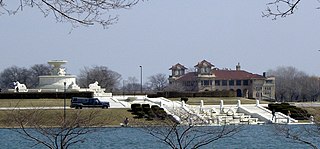
Belle Isle Park, known simply as Belle Isle, is a 982-acre island park in Detroit, Michigan, developed in the late 19th century. It consists of Belle Isle, an island in the Detroit River, as well as several surrounding islets. The U.S.-Canada border is in the channel south of Belle Isle.

The Sophia M. Sachs Butterfly House is a butterfly zoo operated by the Missouri Botanical Gardens, and located in Faust Park in Chesterfield, Missouri, United States.

Allan Gardens is a conservatory and urban park located in the Garden District of Toronto, Ontario, Canada. The property includes a playground, off-leash dog park, and a 1,500 square metres (16,000 sq ft) conservatory with six green houses.

The Anna Scripps Whitcomb Conservatory is a greenhouse and a botanical garden located on Belle Isle, a 982-acre (397-hectare) island park located on the Detroit River within Detroit, Michigan. While located near the Canada–United States border, the island is entirely within the U.S. The park itself consists of 13 acres of preserved land for the conservatory and its botanical garden.

Kohleria hirsuta, the woolly kohleria, is a species of flowering plant in the family Gesneriaceae, native to northern South America, and introduced to the Dominican Republic. In 1993, as its synonym Kohleria eriantha, it gained the Royal Horticultural Society's Award of Garden Merit as a hothouse plant, but the award appears to have been recently revoked.


















